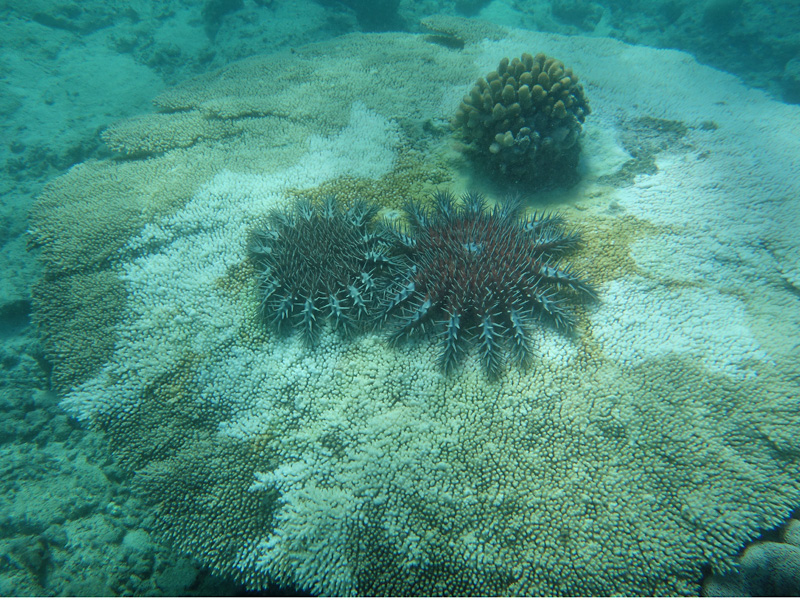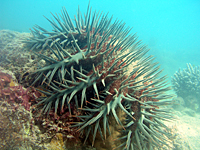
©Anne: Two Crown-of-thorns Starfish (COTS) feeding on a large table coral (Acropora, more than 3 metres in diameter). White patches on the coral are dead skeleton, left after the COTS have eaten the living tissue.
Colours
Distinguishing features
They are large and covered in sharp spines.
They are usually of subdued colours, pale brown to grey-green, but they may be garish with bright warning colours in some parts of their wide range. (Wikipedia)
Size
- Up to 45 cm (Diameter)
Depth range
- Depth range data is not yet available.
Synonyms
Similar taxa
-
Animalia:
species: Acanthaster brevispinus
Acanthaster brevispinus has dense blunt spines over the upper (aboral) surface of its disc,
short pedicillaria on its aboral surface purple-brown aboral surface becoming more intense along the arms, blotches of darker colour around the perimeter of the disc and along the arms, including a large blotch at the base of each arm, pale marks on the disc between each arm, and spines along it arms which are not as long as in Acanthaster planci. (Wikipedia)
Comments
When the starfish is removed from the water, the body surface ruptures and the body fluid leaks out, so the body collapses and flattens. The spines bend over and flatten, as well. They recover their shape when reimmersed, if they are still alive. (Wikipedia)
by Geoffrey Shuetrim
Distribution
Distribution and habitat preferences
It occurs at tropical and subtropical latitudes from the Red Sea and the east African coast across the Indian Ocean, and across the Pacific Ocean to the west coast of Central America. It occurs where coral reefs or hard coral communities occur in this region. (Wikipedia)
Maximum number of arms (echinoderms)
Behaviour
Spawning observations at Lizard Island:
6 Dec 2013: Lyle Vail and Anne Hoggett killed 37 COTS in 40 minutes on snorkel at the northern end of Big Vicki's Reef between 1800 and 1840. This was just before low tide (0.86 m at 1847), three days after the new moon. One male was spawning profusely from on top of a coral head. Water was very cloudy at start of snorkel indicating others had spawned recently. Normal distribution of individuals, no sign of aggregation, no photos.
18 Dec 2009: At least 12 COTS observed spawning by Anne Hoggett and Lyle Vail on reef crest and slope between South and Palfrey Islands between 4.30 and 5 pm. This was at low tide (1.0 m at 1648) two days after the new moon. All were males, extreme quantities of white sperm distinctly reduced visibility not just in immediate area but generally. Individuals were well spaced from each other, from about 3 to tens of metres from the nearest. Most were exposed on top of coral heads but some were within branching Acropora. Almost all COTS observed were spawning, have photos. When/where do the females do it?
Danielle Dixson observed a COTS on display in the LIRS aquarium spawn the following day (19 Dec 2009) at about 4.30 pm. It appeared to be a female.
Lyle and Anne went back to South/Palfrey for two dives on 19 Dec 2009. No spawning observed on either dive. Killed about 12 COTS on morning dive (about 1045 to 1200, South Island end) and another 12 in the late afternoon (about 1645 to 1745, more towards Palfrey).
1983: Bill Gladstone saw 20 to 30 COTS - all male - spawning on a summer morning. They climbed to the tops of coral heads as the tide was falling and exuded clouds of sperm for 20 to 30 minutes. Bill noted that the animals were well spaced, 3 to 4 metres apart. (Gladstone, 1988).
Web resources
Danger
- significant discomfort - The spines are venomous.
References
- Allen, J.D. (2005). Life-history evolution and the costs of small egg size in echinoderms, Ph.D. thesis, University of North Carolina at Chapel Hill. LIRS catalog number 940.
- Allen, J.D., K.R. Schrage, S.A. Foo, S.-A. Watson and M. Byrne (2017). The effects of salinity and pH on fertilization, early development, and hatching in the Crown-of-Thorns Seastar. Diversity, 9(1): 13. LIRS catalog number 2079.
- Babcock, R.C., D.A. Milton and M.S. Pratchett (2106). Relationships between size and reproductive output in the Crown-of-Thorns Starfish, Marine Biology, 163:234 DOI 10.1007/s00227-016-3009-57, 163:234 DOI 10.1007/s00227-016-3009-577. LIRS catalog number 2052.
- View all references















